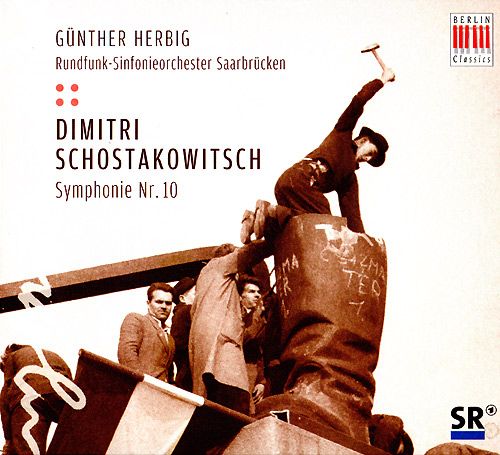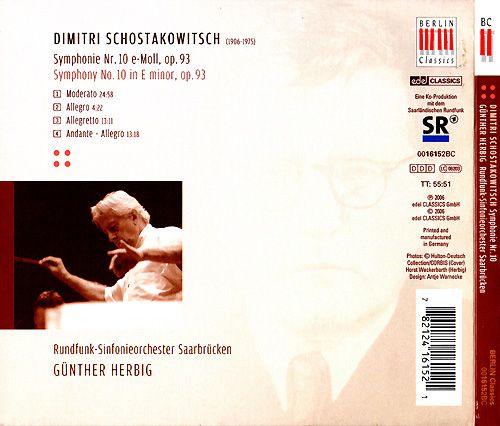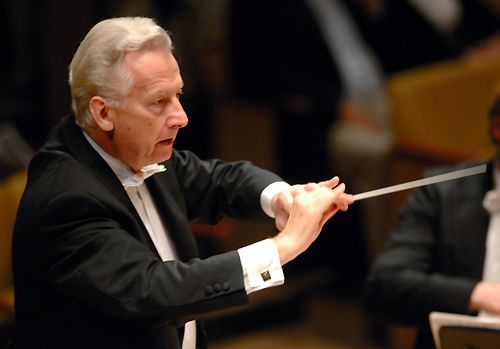wimpel69
11-27-2014, 11:57 AM
EAC-FLAC link below. This is my own rip. Complete artwork,
LOG and CUE files included. Do not share. Buy the original!
Please leave a "Like" or "Thank you" if you enjoyed this!
This was Dmitri Shostakovich's first symphony in eight years, and the gap between this and the
1945 Ninth owed nothing to a lack of inspiration in the genre. In 1948, Shostakovich, Prokofiev,
Khachaturian, and other noted Soviet composers were censured for writing what party censors called
"formalistic" music, a code word for dissonance and the expression of negative emotions or cynicism.
Of course, examined against such vague and, therefore, potentially all-inclusive standards, virtually
any composition could be vulnerable to attack, and many of Shostakovich's were singled out. After
January 1948, most Soviet composers were simply unsure of what was safe to write. Shostakovich
turned to writing patriotic bombast like the choral work Song of the Forests (1949), the cantata The
Sun Shines on Our Motherland (1952), as well as vapid film scores like that for the 1950 release
The Fall of Berlin.
On March 5, 1953, Stalin died. The stringent policies in the arts loosened somewhat in the aftermath
of the dictator's passing, and Shostakovich seized the opportunity to write a large symphony, not
least because he could satirize Stalin in it. In fact, the second movement is said to be a depiction of
the Soviet tyrant. The music in this Allegro is angry and intense, but also quite Russian. Certainly,
it can be heard as austere and hostile, sinister and threatening, thereby painting an effective and
credible portrait of Stalin, but it might also express anxiety and fear, emotions hardly new to
Shostakovich. Thus, the "Stalin" interpretation of this movement, while quite possibly valid, is
not fully convincing, much less verifiable.
The Symphony No.10 opens up with a Moderato movement that is nearly as long as the ensuing
three movements combined. The mood is dark and brooding and the structure is not unlike that
of the Eighth's opening section: there is an introductory theme, followed by two "main" themes.
Here, the second of those is faster than its counterpart in the Eighth, and while the atmosphere is
intense in the exposition and development section, there is a relaxation in intensity in the recapitulation
and coda, where the Eighth remains mired in darkness.
As suggested above, the second movement is a biting, sinister piece. It is followed by an Allegretto
of decidedly Russian character, whose mood brightens somewhat, especially in the middle section.
This movement is notable because it is the first time that Shostakovich used his personal motto, D-E
flat-C-B, which, via German transliteration, represents his initials, DSCH. This motif would appear in
numerous subsequent works by the composer, like the Violin Concerto No. 1 (1947-1948; rev. 1955)
and his popular String Quartet No. 8 (1961).
The finale starts off with an Andante that seems mired in a slow-motion haze. Suddenly the mood
turns joyous and playful, lively and colorful. An austere middle section recalls the opening gloom,
but the cheerful music returns and the symphony ends in a blaze of ecstatic joy. The Symphony No.10
was premiered in Leningrad on December 17, 1953, under the baton of Yevgeny Mravinsky. It has become,
with the Symphony No.5, Shostakovich's most often performed and recorded symphony.

Music Composed by
Dmitri Shostakovich
Played by the
Saarbr�cken Radio Symphony Orchestra
Conducted by
G�nther Herbig

"I found Herbig�s Mahler Ninth (reviewed last issue) to be on the cool side, interpretively. While it�s
presumptuous to generalize, the kind of stark drama so prevalent in the Shostakovich symphony heard
here seems to elicit a stronger response from this conductor.
In the first movement, the kind of emphasis and emotional contrast that I felt was often missing in the
Mahler performance is evident. Here is the regret, the anger, and most of all, the profound sense of
melancholy that pervade this movement. The towering climax at its heart is all one would wish�
screaming winds, slashing strings, and dramatic percussion. The sinuous, seductive clarinets that
restate the flute theme (itself beautifully somber) after order has been restored have a decidedly
mournful air. The rest of the winds add a bit more life to the theme as they take it up, but the mood
is far from jolly; the flutes in the mysterious coda add just the right touch. At almost 25 minutes,
this performance is among the more expansive, but it never feels slow or ponderous, such is the
integrity of the interpretation.
The manic Allegro is further evidence of the effectiveness of the performance: this dynamic, angry
music can�t be allowed to flag, and Herbig maintains the momentum, and his orchestra is right
there with him. The Allegretto insinuates itself with quiet determination, borrowing the mournful
quality of the opening movement. After the jaunty, disjointed attempt at jollification, we are
indeed back in the mood of the first movement, signaled by the horn call. This is all very effectively
done, the horn sounding more mysterious than commanding, and eliciting responses from
the orchestra that heighten the mystery�until that hopelessly hollow march barges in.
After a suitably brooding Andante, the finale�s march erupts with a particularly impish clarinet,
then gathers steam. However one feels about this part of the movement�Michael Steinberg
refers to the composer�s debt to Hayden�it is carried off with aplomb, leavened with a touch
of delicacy and wit, by Herbig and the orchestra.
The sound affords the listener a midhall perspective, and some detail is smoothed over or
indistinct, especially in the louder passages for percussion; I would have preferred a sharper
focus and a higher dynamic level with more impact, but in general there is decent definition
and fidelity in the production.
One mystery remains: reference is made to members of the youth orchestra, who are credited
in the booklet with �assisting� the RSO; what form that assistance took, and how many
members of the other orchestra participated, is not stated.
There are relatively few recordings of the 10th that have maintained a prominent place in my
library. Karajan/DG remains near the top, along with Rostropovich (available on Elatus as an
import); of relatively recent vintage, Jansons still holds sway, and EMI has the edge in sound
over this new issue; only time will tell whether Herbig�s account has the staying power to
share space with these others.
From the photos printed in the inside back cover of the booklet, there are several more
Shostakovich symphonies available (or pending) from these performers. I will definitely
be on the lookout, based on the success of this performance."
Christopher Abbot, Fanfare

Download Link - https://mega.co.nz/#!iEpjRaTL!iSUOHUTj6GKfMDG8rt2fyIgRmllgayY6rzzYcBd 8Hno
Source: Berlin Classics/Edel CD, 2006 (my rip!)
Format: FLAC(RAR), DDD Stereo, Level: -5
File Size: 259 MB (incl. artwork, booklet, log & cue)
Enjoy! Don't share! Buy the origina! Please leave a "Like" or "Thank you" if you enjoyed this! :)
LOG and CUE files included. Do not share. Buy the original!
Please leave a "Like" or "Thank you" if you enjoyed this!
This was Dmitri Shostakovich's first symphony in eight years, and the gap between this and the
1945 Ninth owed nothing to a lack of inspiration in the genre. In 1948, Shostakovich, Prokofiev,
Khachaturian, and other noted Soviet composers were censured for writing what party censors called
"formalistic" music, a code word for dissonance and the expression of negative emotions or cynicism.
Of course, examined against such vague and, therefore, potentially all-inclusive standards, virtually
any composition could be vulnerable to attack, and many of Shostakovich's were singled out. After
January 1948, most Soviet composers were simply unsure of what was safe to write. Shostakovich
turned to writing patriotic bombast like the choral work Song of the Forests (1949), the cantata The
Sun Shines on Our Motherland (1952), as well as vapid film scores like that for the 1950 release
The Fall of Berlin.
On March 5, 1953, Stalin died. The stringent policies in the arts loosened somewhat in the aftermath
of the dictator's passing, and Shostakovich seized the opportunity to write a large symphony, not
least because he could satirize Stalin in it. In fact, the second movement is said to be a depiction of
the Soviet tyrant. The music in this Allegro is angry and intense, but also quite Russian. Certainly,
it can be heard as austere and hostile, sinister and threatening, thereby painting an effective and
credible portrait of Stalin, but it might also express anxiety and fear, emotions hardly new to
Shostakovich. Thus, the "Stalin" interpretation of this movement, while quite possibly valid, is
not fully convincing, much less verifiable.
The Symphony No.10 opens up with a Moderato movement that is nearly as long as the ensuing
three movements combined. The mood is dark and brooding and the structure is not unlike that
of the Eighth's opening section: there is an introductory theme, followed by two "main" themes.
Here, the second of those is faster than its counterpart in the Eighth, and while the atmosphere is
intense in the exposition and development section, there is a relaxation in intensity in the recapitulation
and coda, where the Eighth remains mired in darkness.
As suggested above, the second movement is a biting, sinister piece. It is followed by an Allegretto
of decidedly Russian character, whose mood brightens somewhat, especially in the middle section.
This movement is notable because it is the first time that Shostakovich used his personal motto, D-E
flat-C-B, which, via German transliteration, represents his initials, DSCH. This motif would appear in
numerous subsequent works by the composer, like the Violin Concerto No. 1 (1947-1948; rev. 1955)
and his popular String Quartet No. 8 (1961).
The finale starts off with an Andante that seems mired in a slow-motion haze. Suddenly the mood
turns joyous and playful, lively and colorful. An austere middle section recalls the opening gloom,
but the cheerful music returns and the symphony ends in a blaze of ecstatic joy. The Symphony No.10
was premiered in Leningrad on December 17, 1953, under the baton of Yevgeny Mravinsky. It has become,
with the Symphony No.5, Shostakovich's most often performed and recorded symphony.

Music Composed by
Dmitri Shostakovich
Played by the
Saarbr�cken Radio Symphony Orchestra
Conducted by
G�nther Herbig

"I found Herbig�s Mahler Ninth (reviewed last issue) to be on the cool side, interpretively. While it�s
presumptuous to generalize, the kind of stark drama so prevalent in the Shostakovich symphony heard
here seems to elicit a stronger response from this conductor.
In the first movement, the kind of emphasis and emotional contrast that I felt was often missing in the
Mahler performance is evident. Here is the regret, the anger, and most of all, the profound sense of
melancholy that pervade this movement. The towering climax at its heart is all one would wish�
screaming winds, slashing strings, and dramatic percussion. The sinuous, seductive clarinets that
restate the flute theme (itself beautifully somber) after order has been restored have a decidedly
mournful air. The rest of the winds add a bit more life to the theme as they take it up, but the mood
is far from jolly; the flutes in the mysterious coda add just the right touch. At almost 25 minutes,
this performance is among the more expansive, but it never feels slow or ponderous, such is the
integrity of the interpretation.
The manic Allegro is further evidence of the effectiveness of the performance: this dynamic, angry
music can�t be allowed to flag, and Herbig maintains the momentum, and his orchestra is right
there with him. The Allegretto insinuates itself with quiet determination, borrowing the mournful
quality of the opening movement. After the jaunty, disjointed attempt at jollification, we are
indeed back in the mood of the first movement, signaled by the horn call. This is all very effectively
done, the horn sounding more mysterious than commanding, and eliciting responses from
the orchestra that heighten the mystery�until that hopelessly hollow march barges in.
After a suitably brooding Andante, the finale�s march erupts with a particularly impish clarinet,
then gathers steam. However one feels about this part of the movement�Michael Steinberg
refers to the composer�s debt to Hayden�it is carried off with aplomb, leavened with a touch
of delicacy and wit, by Herbig and the orchestra.
The sound affords the listener a midhall perspective, and some detail is smoothed over or
indistinct, especially in the louder passages for percussion; I would have preferred a sharper
focus and a higher dynamic level with more impact, but in general there is decent definition
and fidelity in the production.
One mystery remains: reference is made to members of the youth orchestra, who are credited
in the booklet with �assisting� the RSO; what form that assistance took, and how many
members of the other orchestra participated, is not stated.
There are relatively few recordings of the 10th that have maintained a prominent place in my
library. Karajan/DG remains near the top, along with Rostropovich (available on Elatus as an
import); of relatively recent vintage, Jansons still holds sway, and EMI has the edge in sound
over this new issue; only time will tell whether Herbig�s account has the staying power to
share space with these others.
From the photos printed in the inside back cover of the booklet, there are several more
Shostakovich symphonies available (or pending) from these performers. I will definitely
be on the lookout, based on the success of this performance."
Christopher Abbot, Fanfare

Download Link - https://mega.co.nz/#!iEpjRaTL!iSUOHUTj6GKfMDG8rt2fyIgRmllgayY6rzzYcBd 8Hno
Source: Berlin Classics/Edel CD, 2006 (my rip!)
Format: FLAC(RAR), DDD Stereo, Level: -5
File Size: 259 MB (incl. artwork, booklet, log & cue)
Enjoy! Don't share! Buy the origina! Please leave a "Like" or "Thank you" if you enjoyed this! :)